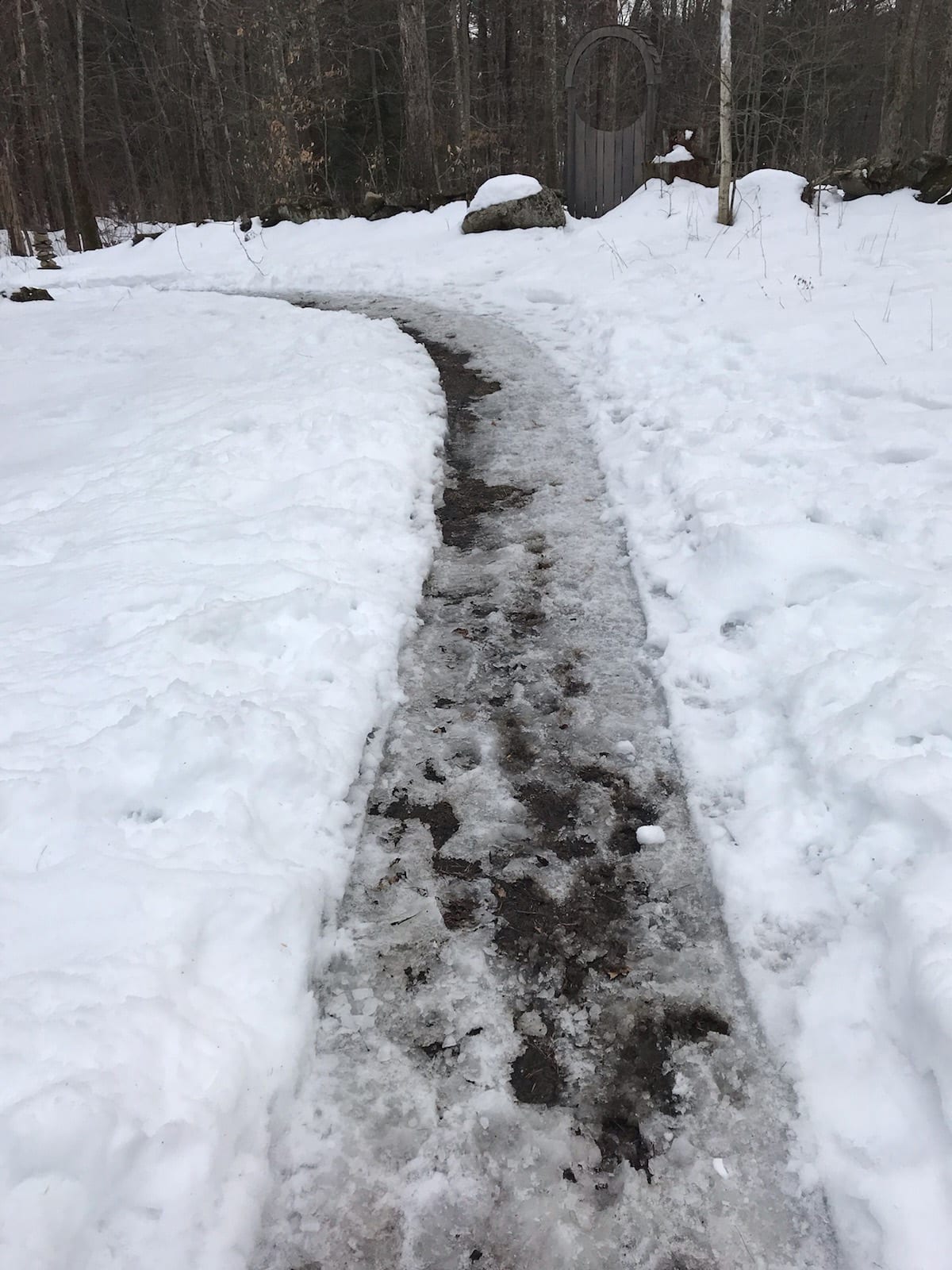by Maureen Sundberg
In March, crocus pop up from a warm spot in the garden while snow and ice patches still cover the lawn and beds. You’re anxious to get out into the yard, but that melting snow and ice has saturated the soil. Your best course of action? Stop yourself.
Saturated soil can occur at any time of the year, but in early spring when we are most anxious to get out into the landscape, it’s especially important to stay out of the garden and avoid working the soil too soon to prevent soil compaction. When we walk on, drive over, or dig into saturated soil, we collapse the crucial pore spaces in the soil, compacting the soil. Once the damage is done, soil compaction can be a difficult problem to solve.
What’s the consistency of healthy soil?
One foundational principle of ecological landscaping is developing and maintaining healthy soils. Plants grow best in soil that consists of both solid particles and pore spaces in about a 1:1 ratio. That’s equally true of grass plants in a lawn, and of shrubs and perennials in flower beds. Good quality soil includes a mix of soil components like sand, silt, clay, and organic matter, but also has plenty of space between soil particles, allowing air and water to move freely and providing living space for beneficial soil microorganisms and for larger organisms like earthworms. An ideal soil tends to have a loose composition. Highly compressed soils are dense with fewer and smaller pore spaces. Nutrients, water, oxygen, and microorganisms cannot move through dense soils to reach a plant’s roots and the plant fails.
Take steps to avoid compaction
Compaction often occurs when there is repeated foot or vehicular traffic over the same path. In the home garden, it might be the path from the back door to the compost pile, or from a side door to a driveway. These are paths we have difficulty avoiding even when the soil is saturated.
Working soil when it is too wet can also destroy soil structure by closing up the pore spaces. Before digging in, make sure that the soil is dry enough to work by conducting a simple “ball test.” Pick up a handful of soil and squeeze it into a ball. If the soil sticks together and forms a ball, it is too wet to work or walk and drive on. If the soil crumbles with a gentle poke, it is dry enough to be more resistant to the forces of compaction.
What are the negative effects of soil compaction?
Remember that soil is a living medium. When soil loses space for air, water, soil organisms, and plant roots, it becomes very dense. In dense, heavy soil, plants and soil life suffer, as noted in ELA’s Guide to Healthy Landscapes:
- Compacted soil prevents water and oxygen from reaching the root system, resulting in poor plant growth and disease. Compaction may even cause the death of a plant.
- Compacted soil creates a barrier that prevents roots from growing deeply in search of nutrients and water.
- Compacted soil causes a loss of pore space and consequently the loss of oxygen in the soil. This slows the decomposition process that provides plants with required nutrients, resulting in a reduction of available nutrients.
- Loss of pore space reduces habitat for soil microorganisms that typically live in and move through these spaces. This further decreases the availability of nutrients to plants and other soil organisms.
- Compaction reduces earthworm populations in the soil. This reduces rainwater infiltration rates and may result in increased runoff and erosion.
- Compaction at the base of a planting hole or area, referred to as hardpan, results in poor drainage, causing water to sit as though in a bowl. Roots sitting in water cannot get oxygen and the plant slowly declines and dies by drowning.
- Compaction may create surface crusting that increases runoff and erosion and encourages weeds, which thrive in compacted soils.
While active garden work may be a few weeks off, you can take time now to imagine the paths you would like to have and the parts of the landscape you would like to access even in saturated conditions. Defined paths will help protect the rest of the garden from foot traffic and give you early access to those parts of the garden you’ll be itching to get to next spring.
Resources
ELA’s Guide to Healthy Landscapes, Volume 1, 2003.
What to do about compacted soil, Michigan State University Extension, February 21, 2014.
About the Author
Maureen Sundberg edits the ELA Newsletter and is ELA’s Administrative Assistant.
***
Each author appearing herein retains original copyright. Right to reproduce or disseminate all material herein, including to Columbia University Library’s CAUSEWAY Project, is otherwise reserved by ELA. Please contact ELA for permission to reprint.
Mention of products is not intended to constitute endorsement. Opinions expressed in this newsletter article do not necessarily represent those of ELA’s directors, staff, or members.


